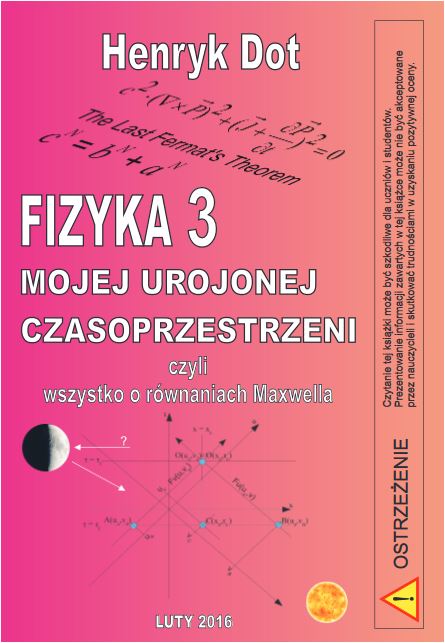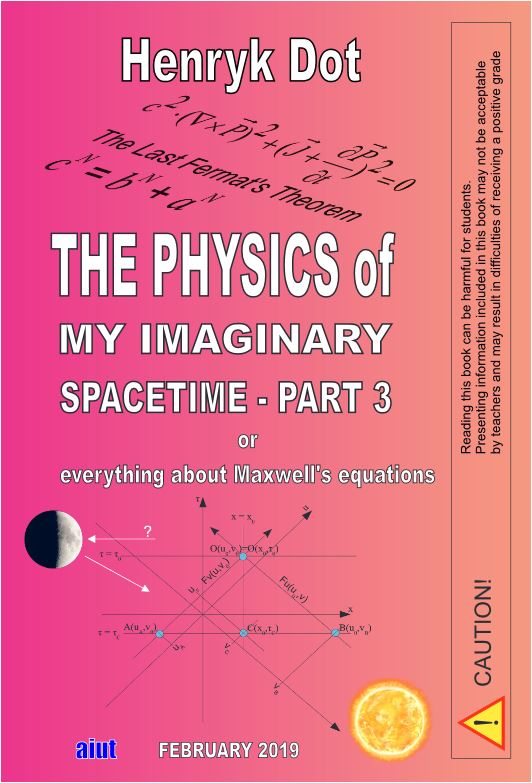|
I.3. New aspects regarding Maxwell’s equations
It is interesting, besides equations themselves,
what inspired Maxwell to complement Ampere’s equation by dynamic component.
Maxwell never disclosed it, surfacing speculations are only speculations.
Should anyone be interested what inspired
the author of this book, I will explain how some parts of the book were created.
This should clarify some doubts regarding “new ideas”.
It is worth to mention, when Maxwell worked on his equations,
the existence of electron was not known.
I suppose that one of the reasons to add dynamic component to Ampere’s law was to make
it similar to Faraday’s law. Further expansion by magnetic monopole and magnetic current
allowed for full symmetry of Maxwell’s equations.
Existence or non-existence of magnetic monopoles is not essential to Maxwell’s
equations since with magnetic monopole they just have more general form.
Consideration of magnetic monopole
is significant for known solution of Maxwell’s equations based on L. Lorenz’ gauge
where magnetic monopole cannot be used because divergence (div)
of magnetic field B is different than zero,
while Lorenz’ gauge assumes that div B=0.
This limitation resulted in search
for a solution of Maxwell’s equations treated as mathematical problem in its general form
with magnetic monopoles and magnetic current.
Maxwell’s equations complemented by magnetic monopoles and magnetic current form
set of linear partial differential equations
with constant coefficients where similarity between electrical field E
and magnetic field B equations can be recognized.
The solution for this equation set can be
very easily derived when we do not consider sources of fields E and B.
The equation set can be then simplified to two independent, the same equations
for both E and B fields, known as wave equations.
In electrical field E and magnetic field B equations, different signs “+” and “-“
became only “-“ sign in wave equations. The question then arises “Where and why?”
To find the answer, the original set of equations was replaced by equations representing
their sum and difference using respectively multipliers “a” and “b”.
It is then expected that in further processing, observation of “difference equation”
behavior will unveil the “secret” of sign change.
Such approach to the research of this problem may seem incorrect
since instead of original two variables we have now additional four new variables.
However, coefficients “a” and “b” can be any value and can be chosen such
that new variables in the same equation became identical.
This reduces the number of variables back to two, and in addition results
in complete separation of variables and their associated equations.
CHAPTER 1, Section 1.3 presents in detail
the process of deriving values for coefficients ‘a” and “b” which proved to involved
the imaginary number “i”. This has led to new form of variable as a complex variable
which includes both values E and B.
The creation of new complex variables representing values of current
and electrical charge (similarly to variable created for fields E and B)
and their further use in Maxwell’s equations allowed for expressing
two equations in form of one.
I have presented my derived form
of Maxwell’s equations to various physicists and asked whether they were familiar
with such form of these equations. Unfortunately, I have not received any answers
nor suggestions that it is worth to publish. My apprehension of discredit
due to possible error in my form of equations prevented me from premature publication.
Several years later,
the article by prof. Birula-Bialynicki referring to Silberstein’s vector assured me
that association of magnetic field with imaginary space is the right approach.
I dared then to publish my ideas
regarding Maxwell’s equations in my book issued in April 2006
– “Fizyka Mojej Urojonej Czasoprzestrzeni” ISBN 978-83-921213-5-0.
I sent the book to prof. Birula-Bialynicki who concluded that everything
in my book regarding Maxwell’s equations is already written
in his article in “Postepy Fizyki”. publication.
My question – “Have you noticed any differences?” remained unanswered.
The differences are substantial since:
1. In the article, Silberstein’s vector covers fields E and B only for no-source
waves while my book considers full form of Maxwell’s equations including
sources, and in addition includes most general case including magnetic
monopole and magnetic current.
2. Solution presented in the article uses Lorenz’ gauge which cannot be applied
for case when magnetic monopole is considered.
3. My book presents simple solution without Lorenz’ gauge.
-
Silberstein’s vector description and creation of new complex variable
for fields E and B as well as new complex variables for sources are presented
in my first book ( Fizyka 1). It may seem like these concepts were guessed
rather than mathematically derived.
-
However, this book presents mathematical derivation of complex variables
from original equations. The differences (from article) pointed out above
and derivation of substitutions are new topics. Author uses substitutions
a = 1/c and b = i (i = imaginary number) since they result in shorter equations,
but other substitutions are also possible.
-
Summarizing, new subjects in this book (besides derivation of complex variable
for fields E and B) include:
•
Use of the same approach for field sources, which allowed firstly to reduce
two equations to one, and then without using Lorenz’ gauge to formulate
separate equations for E and B waves along with respective sources.
•
It was also pointed out that well known form of Maxwell’s equations results
from assumed positive rotation in a three-dimensional coordinate system,
but it is not the only possible form of these equations. More general form
is proposed including both possible expressions – for left-handed
and righ-handed coordinate system.
•
The solutions for various types of sources are discussed in detail, while
paying special attention to mathematical correctness and eliminating
limitations present in earlier solutions.
Besides new aspects regarding Maxwell’s equations,
this book contains new topics included in supplement related to mathematical
and other problems.
These are:
1. Proof of Fermat's Last Theorem
2. Explanation of the origin of inertia mass and E = m·c2 equation
3. Interesting relation between gravitational constant G and speed of light
4. Why the Moon is “not looking" at the Sun
|


